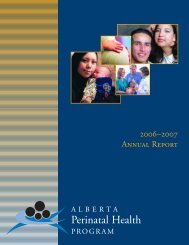Assistive Reproductive Technologies: A Literature Review and ...
Assistive Reproductive Technologies: A Literature Review and ...
Assistive Reproductive Technologies: A Literature Review and ...
You also want an ePaper? Increase the reach of your titles
YUMPU automatically turns print PDFs into web optimized ePapers that Google loves.
n Search ResultsThere were 811 published documents identified from the literature search (seeAppendix A for the search strategy, study selection, <strong>and</strong> data extraction). Afterreviewing their titles <strong>and</strong> abstracts, 110 studies were retrieved for further evaluation.Of the 110 studies, 18 met the final inclusion/exclusion criteria. Seven studies wererelated to the association between ARTs <strong>and</strong> increased health services costs <strong>and</strong>eleven were related to reducing the number of embryo transfers.n Evidence from Published <strong>Literature</strong>Cost impact of ARTs on the health care systemKoivurova et al. 6 conducted a retrospective observational study comparing postneonatalhospital costs between IVF/ICSI children <strong>and</strong> matched controls forsingleton, twin, triplet, <strong>and</strong> quadruplet births (refer to Appendix B). Data wascollected from the Finnish Hospital Discharge Register <strong>and</strong> for each child inthe study included cost data from birth until 7 years of age. The costing wasconducted from a payer’s perspective <strong>and</strong> costs were expressed in 2004 Euros.Results indicate that compared to controls, IVF children had a significantlyhigher number of admissions to hospital on average (1.76 vs. 1.07) <strong>and</strong> a longeraverage length of stay (4.31 vs. 1.07). Costs of IVF children were 2.6 times greaterthan controls (€205.8 vs. €79.6 per child). However, the higher costs associatedwith IVF children were driven by comparisons between singleton births (i.e. IVFsingleton vs. natural singleton). No statistically significant findings were foundbetween IVF twin births <strong>and</strong> control twin births. In fact, IVF twin births hadlower costs than their matched controls. Limitations with the study were thatit did not include other relevant costs (e.g. ambulatory care <strong>and</strong> primary careutilization including physician visit costs), lack of sensitivity analysis, <strong>and</strong> did notindicate whether they used discounting to st<strong>and</strong>ardized costs to 2004. Theseresults suggest that ARTs singletons are associated with higher hospital costs thannaturally conceived singletons.Chambers et al. 7 conducted a retrospective observational study comparingaverage inpatient hospital costs between ARTs <strong>and</strong> non-ARTs singletons, twins,<strong>and</strong> HOMs of both infants <strong>and</strong> mothers. Specifically, cost comparisons weremade between ART singletons, twins, <strong>and</strong> HOMs with non-ART counterparts<strong>and</strong> between ART singletons, twins, <strong>and</strong> HOMs. The ART study population wasderived from the Australian <strong>and</strong> New Zeal<strong>and</strong> Assisted <strong>Reproductive</strong> Databasewhich collects information on all ARTs treatment cycles, including perinataloutcomes in Australia <strong>and</strong> New Zeal<strong>and</strong> (5005 mothers who gave birth to 5886live born infants conceived following ARTs in 2003). The non-ART populationwas sourced from the Australian National Perinatal data collection which is across sectional database of all births in Australia including perinatal outcomes(250,254 mothers who gave birth to 254,425 live born infants conceived4 <strong>Assistive</strong> <strong>Reproductive</strong> <strong>Technologies</strong>:a <strong>Literature</strong> <strong>Review</strong> <strong>and</strong> Database Analysis
















